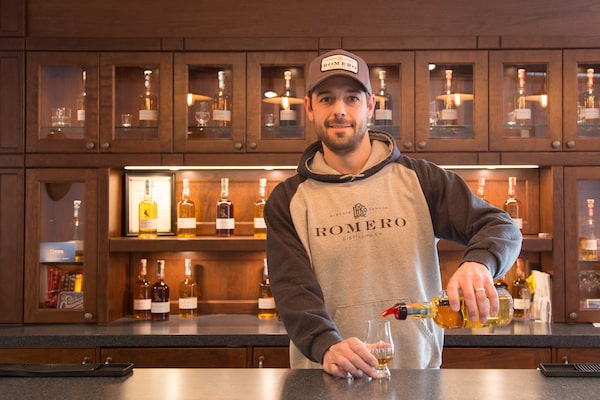
Tomas Romero of Romero Distilling Co. likes that he’s a bit of an oddity in Alberta, since it makes him stand out in what may become a saturated craft spirits market.
Tomas Romero is standing behind a bar in his Calgary tasting room, pouring customers a flight of spirits that were distilled just a few feet away. In a part of the country rich with fields of wheat and barley, Romero wanted to get in on the wave of new and interesting craft distilleries that is rolling across Canada eschewing domestically grown crops by exclusively producing rum.
In an industry that brags about making the most of local ingredients, the growing craft rum market in Canada is a bit of an outlier. By definition, rum is made by fermenting and distilling fresh sugarcane juice or sugarcane molasses. Sugarcane does not readily grow in Canada, making it impossible for rum distillers to create a strictly local product. But as interest in other locally made artisanal alcohol grows, so does the thirst for artfully produced Canadian rum.
The concept of Canadian rum is not new. Screech, Newfoundland’s most famous tipple, is a rum, but as with many larger Canadian rum labels, the spirit itself is fermented and distilled in the Caribbean, then augmented and bottled in Canada. Newer craft distillers have gotten around the sugarcane problem by developing rum alternatives: Devine Spirits in Victoria makes a rum-like spirit with fermented honey, and Rig Hand Distillery out of Nisku, Alta., sells “brum” made with Alberta-grown sugar beets. Even with those work-arounds on the table, Romero wanted to make traditional rum, and he wanted to do it from scratch.

Ironworks Distillery currently sells several different rums.Raoul Manuel Schnell
Enter Crosby’s Molasses. Based in Saint John, N.B., Crosby’s sources its raw product from Guatemala, but since it’s such an iconic Canadian company, Romero was happy to use it and even orders a special blend for his rum. “Freshly pressed sugarcane juice spoils within 24 hours, so the only option up here is molasses,” Romero says. “It’s not hyper-local, but it’s still Canadian product.”
The Romero Distilling Co. started production and opened its tasting room last year. Romero is currently selling three varieties of “sugarcane spirits”– to officially be rum, the alcohol has to age in-barrel for at least a year – but his matured rum will hit the market in August of this year.
Crosby’s is proving to be a popular made-in-Canada solution for artisanal distillers. Rum culture is particularly strong on the east coast, thanks to its nautical connotations. When Lynne MacKay co-founded Ironworks Distillery in Lunenburg, N.S., a decade ago, she didn’t initially plan on making rum, but soon realized that it was a must in her local market. Ironworks quickly made a name for itself with its from-scratch Crosby’s Molasses-based rums.
The distillery currently sells several different rums, perhaps most notably its Rum Boat Rum, which ages for a number of years in a floating warehouse. MacKay says that the motion of the boat and the muggy ocean air change the way the rum ages, giving the spirit a sense of place, even if she’s using the same molasses that Romero uses in Alberta.
“Our rum sees a lot of humidity because of the moist Maritime climate,” MacKay says. “Rum that ages on the prairies is going to be very different. Rum that ages in the Caribbean is very different as well. There’s an element of terroir that I don’t think any of us were expecting.”
Does all this mean that rum is due for its moment as Canada’s new “it” spirit? As much as both MacKay and Romero would like to see rum surpass whisky or gin as Canada’s favourite artisanal pour, they’re content to see local rums simply find a place behind bars and in home liquor cabinets. Alex Hamer, who runs the Canadian Artisan Spirit Competition, says that he’s seen an uptick in Canadian from-scratch rum, with artisanal rums popping up in Quebec, Ontario and Manitoba, and continuing to grow in the Atlantic provinces. With the lasting popularity of tiki bars and rum-based cocktails, he can see more liquor buyers choosing a Canadian artisanal rum over more familiar mass-produced labels.

Romero hopes that spirit drinkers will start to see rum as more than something to put in a cocktail or mix with cola.
“It’s definitely going to grow, there’s no question in my mind,” Hamer says. “Many of these smaller distilleries are trying to fill a niche. If they can produce a product that fits with what consumers or trade accounts like bars and restaurants are looking for, they’re going to do it.”
Romero likes that he’s a bit of an oddity in Alberta, since it makes him stand out in what may become a saturated craft spirits market. That said, he’s also hoping that as more Canadian craft rums appear, spirit drinkers will start to see rum as more than something to put in a cocktail or mix with cola.
“A lot of people’s experience with rum has only been with something that needs to be mixed pretty heavily,” Romero says. “They haven’t been exposed to those nice quality sipping rums that are out there yet. As people learn about the quality of what’s out there, you may see rum step into the limelight.”
Plan your weekend with our Good Taste newsletter, offering wine advice and reviews, recipes, restaurant news and more. Sign up today.